HRM2003: Performance Management & Retention at Unilever Plc
VerifiedAdded on 2023/06/14
|13
|3776
|190
Report
AI Summary
This report provides an in-depth analysis of managing human resources, focusing on performance management and employee retention within the context of Unilever Plc. The first part discusses performance management as a crucial tool for monitoring and evaluating employee work, exploring various performance measures such as management by objectives, 360-degree feedback, graphic rating scales, and efficiency measures, along with their respective advantages and disadvantages. It also identifies strategies for managers to address poor performance, emphasizing immediate communication, honest feedback, accountability, and performance improvement plans. The second part delves into employee retention, highlighting issues related to salary dissatisfaction, lack of appreciation, and unrealistic expectations, as well as talent management challenges like ineffective hiring strategies and poor technology experiences. The report further discusses the reasons employees leave organizations and the impact on organizational performance, concluding with an evaluation of the need for organizations to maximize employee retention and implement effective retention strategies.
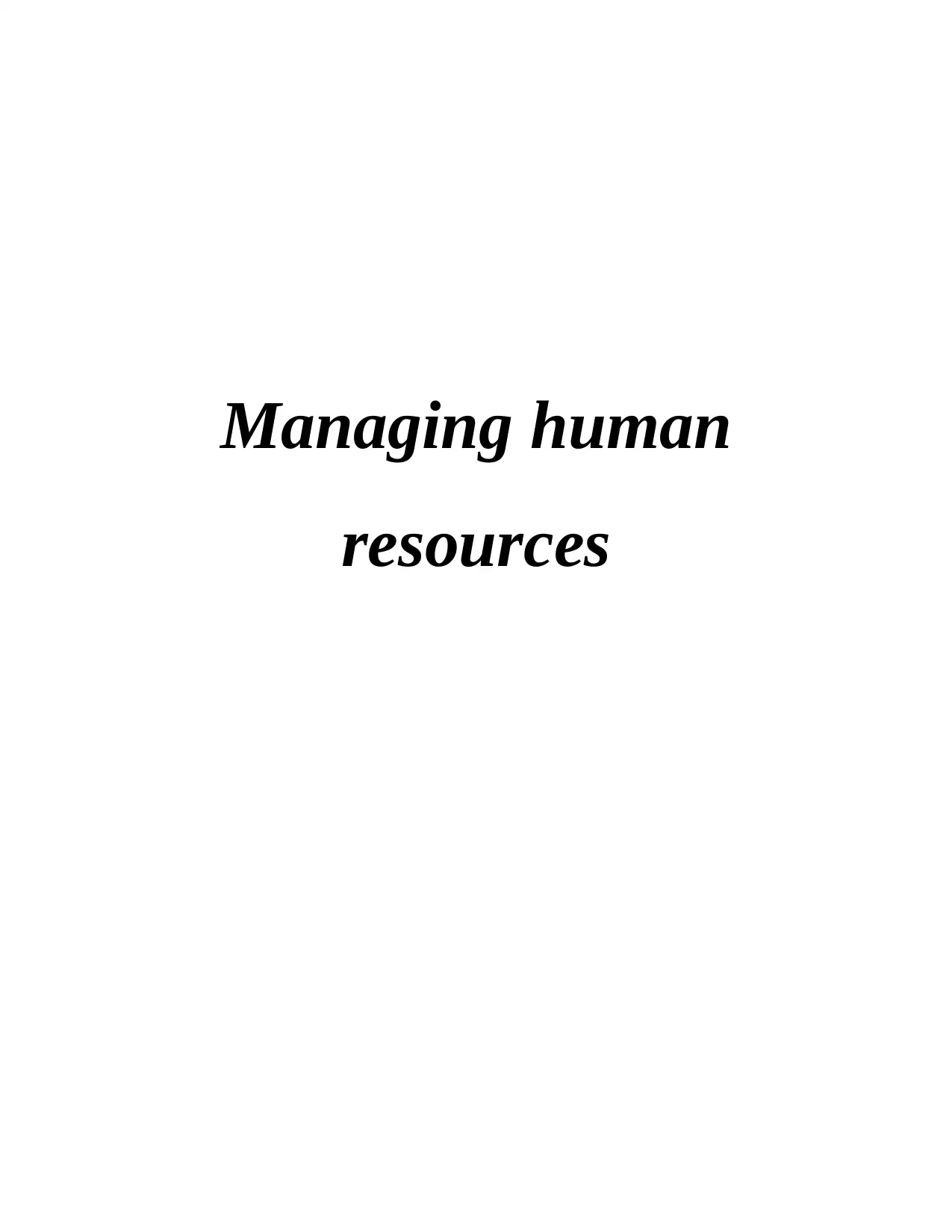
Managing human
resources
resources
Paraphrase This Document
Need a fresh take? Get an instant paraphrase of this document with our AI Paraphraser
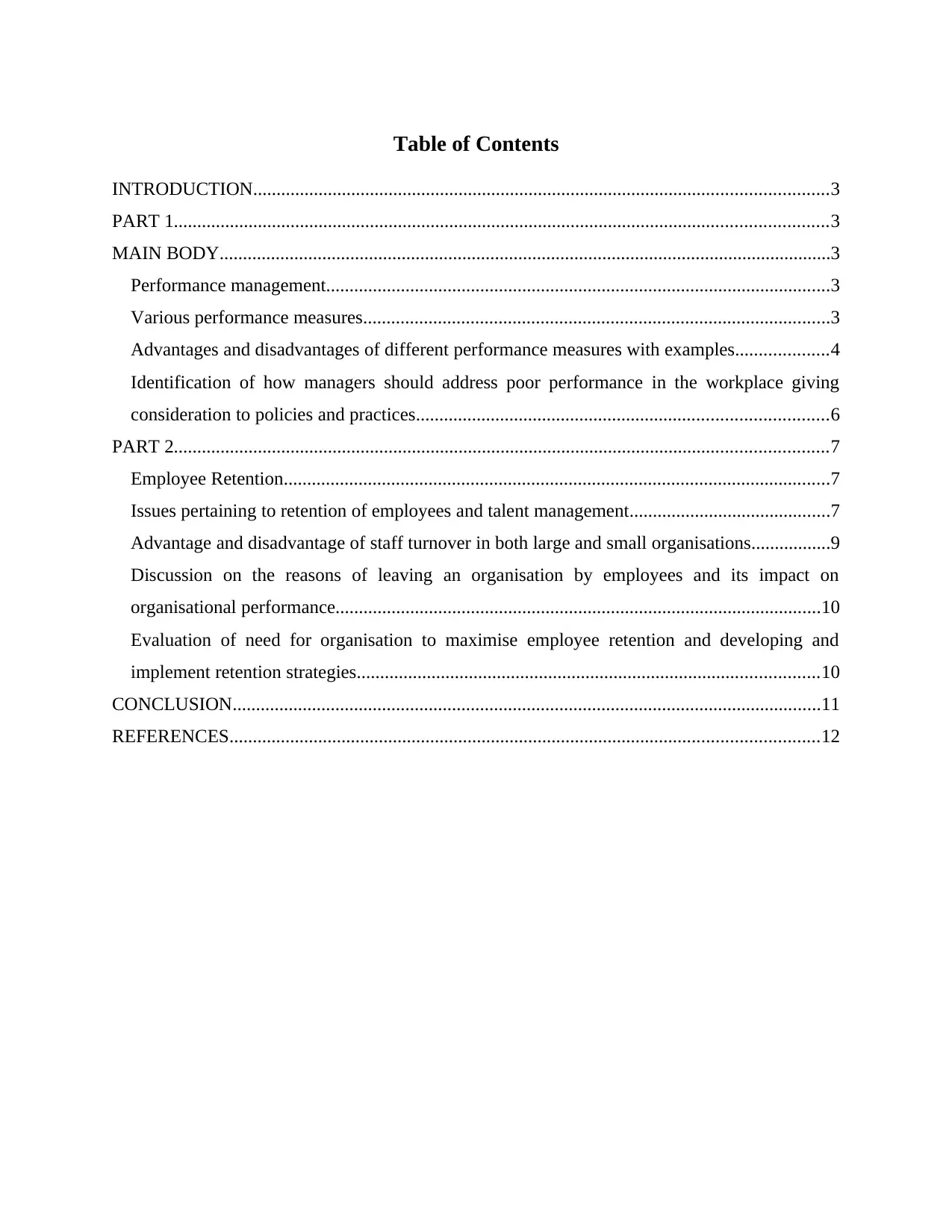
Table of Contents
INTRODUCTION...........................................................................................................................3
PART 1............................................................................................................................................3
MAIN BODY...................................................................................................................................3
Performance management............................................................................................................3
Various performance measures....................................................................................................3
Advantages and disadvantages of different performance measures with examples....................4
Identification of how managers should address poor performance in the workplace giving
consideration to policies and practices........................................................................................6
PART 2............................................................................................................................................7
Employee Retention.....................................................................................................................7
Issues pertaining to retention of employees and talent management...........................................7
Advantage and disadvantage of staff turnover in both large and small organisations.................9
Discussion on the reasons of leaving an organisation by employees and its impact on
organisational performance........................................................................................................10
Evaluation of need for organisation to maximise employee retention and developing and
implement retention strategies...................................................................................................10
CONCLUSION..............................................................................................................................11
REFERENCES..............................................................................................................................12
INTRODUCTION...........................................................................................................................3
PART 1............................................................................................................................................3
MAIN BODY...................................................................................................................................3
Performance management............................................................................................................3
Various performance measures....................................................................................................3
Advantages and disadvantages of different performance measures with examples....................4
Identification of how managers should address poor performance in the workplace giving
consideration to policies and practices........................................................................................6
PART 2............................................................................................................................................7
Employee Retention.....................................................................................................................7
Issues pertaining to retention of employees and talent management...........................................7
Advantage and disadvantage of staff turnover in both large and small organisations.................9
Discussion on the reasons of leaving an organisation by employees and its impact on
organisational performance........................................................................................................10
Evaluation of need for organisation to maximise employee retention and developing and
implement retention strategies...................................................................................................10
CONCLUSION..............................................................................................................................11
REFERENCES..............................................................................................................................12
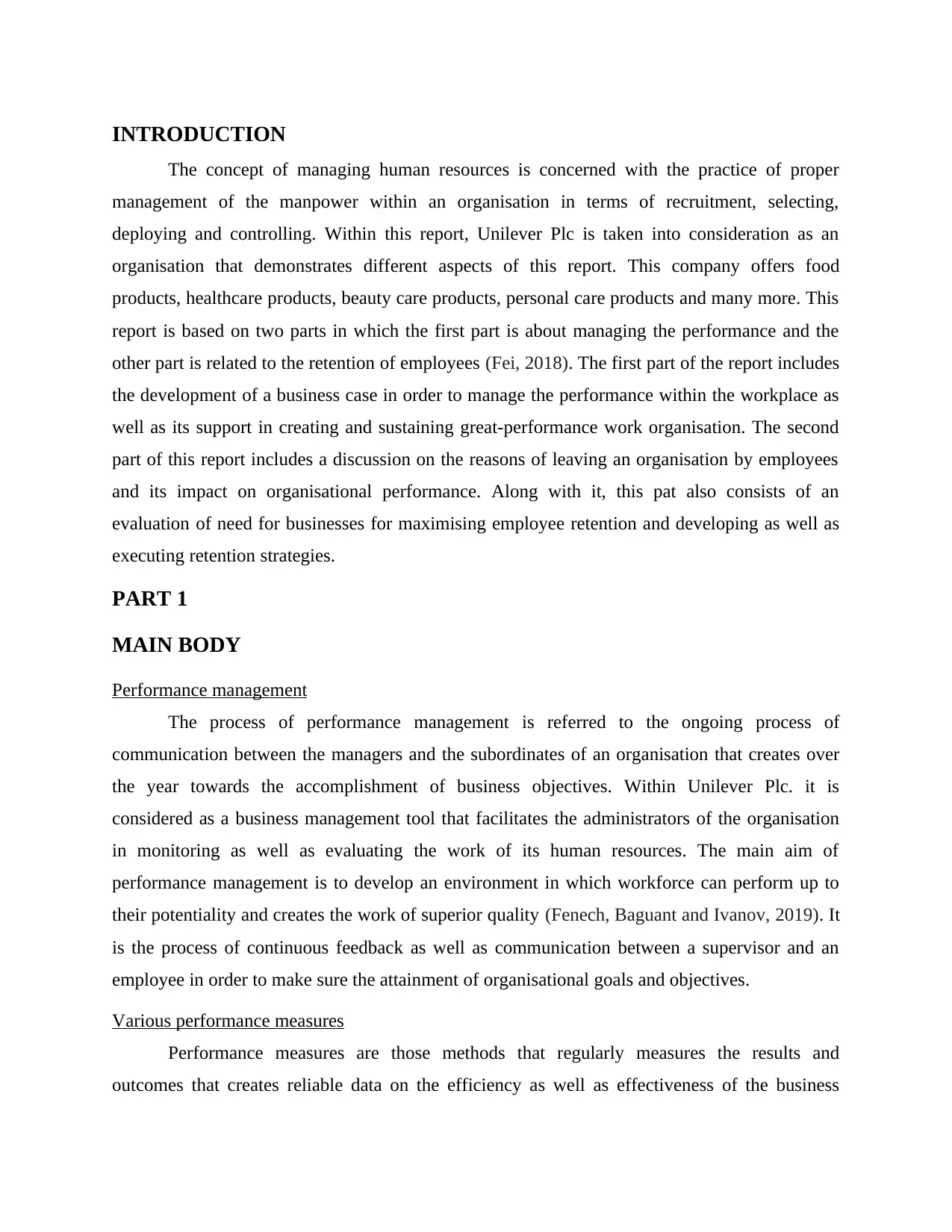
INTRODUCTION
The concept of managing human resources is concerned with the practice of proper
management of the manpower within an organisation in terms of recruitment, selecting,
deploying and controlling. Within this report, Unilever Plc is taken into consideration as an
organisation that demonstrates different aspects of this report. This company offers food
products, healthcare products, beauty care products, personal care products and many more. This
report is based on two parts in which the first part is about managing the performance and the
other part is related to the retention of employees (Fei, 2018). The first part of the report includes
the development of a business case in order to manage the performance within the workplace as
well as its support in creating and sustaining great-performance work organisation. The second
part of this report includes a discussion on the reasons of leaving an organisation by employees
and its impact on organisational performance. Along with it, this pat also consists of an
evaluation of need for businesses for maximising employee retention and developing as well as
executing retention strategies.
PART 1
MAIN BODY
Performance management
The process of performance management is referred to the ongoing process of
communication between the managers and the subordinates of an organisation that creates over
the year towards the accomplishment of business objectives. Within Unilever Plc. it is
considered as a business management tool that facilitates the administrators of the organisation
in monitoring as well as evaluating the work of its human resources. The main aim of
performance management is to develop an environment in which workforce can perform up to
their potentiality and creates the work of superior quality (Fenech, Baguant and Ivanov, 2019). It
is the process of continuous feedback as well as communication between a supervisor and an
employee in order to make sure the attainment of organisational goals and objectives.
Various performance measures
Performance measures are those methods that regularly measures the results and
outcomes that creates reliable data on the efficiency as well as effectiveness of the business
The concept of managing human resources is concerned with the practice of proper
management of the manpower within an organisation in terms of recruitment, selecting,
deploying and controlling. Within this report, Unilever Plc is taken into consideration as an
organisation that demonstrates different aspects of this report. This company offers food
products, healthcare products, beauty care products, personal care products and many more. This
report is based on two parts in which the first part is about managing the performance and the
other part is related to the retention of employees (Fei, 2018). The first part of the report includes
the development of a business case in order to manage the performance within the workplace as
well as its support in creating and sustaining great-performance work organisation. The second
part of this report includes a discussion on the reasons of leaving an organisation by employees
and its impact on organisational performance. Along with it, this pat also consists of an
evaluation of need for businesses for maximising employee retention and developing as well as
executing retention strategies.
PART 1
MAIN BODY
Performance management
The process of performance management is referred to the ongoing process of
communication between the managers and the subordinates of an organisation that creates over
the year towards the accomplishment of business objectives. Within Unilever Plc. it is
considered as a business management tool that facilitates the administrators of the organisation
in monitoring as well as evaluating the work of its human resources. The main aim of
performance management is to develop an environment in which workforce can perform up to
their potentiality and creates the work of superior quality (Fenech, Baguant and Ivanov, 2019). It
is the process of continuous feedback as well as communication between a supervisor and an
employee in order to make sure the attainment of organisational goals and objectives.
Various performance measures
Performance measures are those methods that regularly measures the results and
outcomes that creates reliable data on the efficiency as well as effectiveness of the business
⊘ This is a preview!⊘
Do you want full access?
Subscribe today to unlock all pages.

Trusted by 1+ million students worldwide
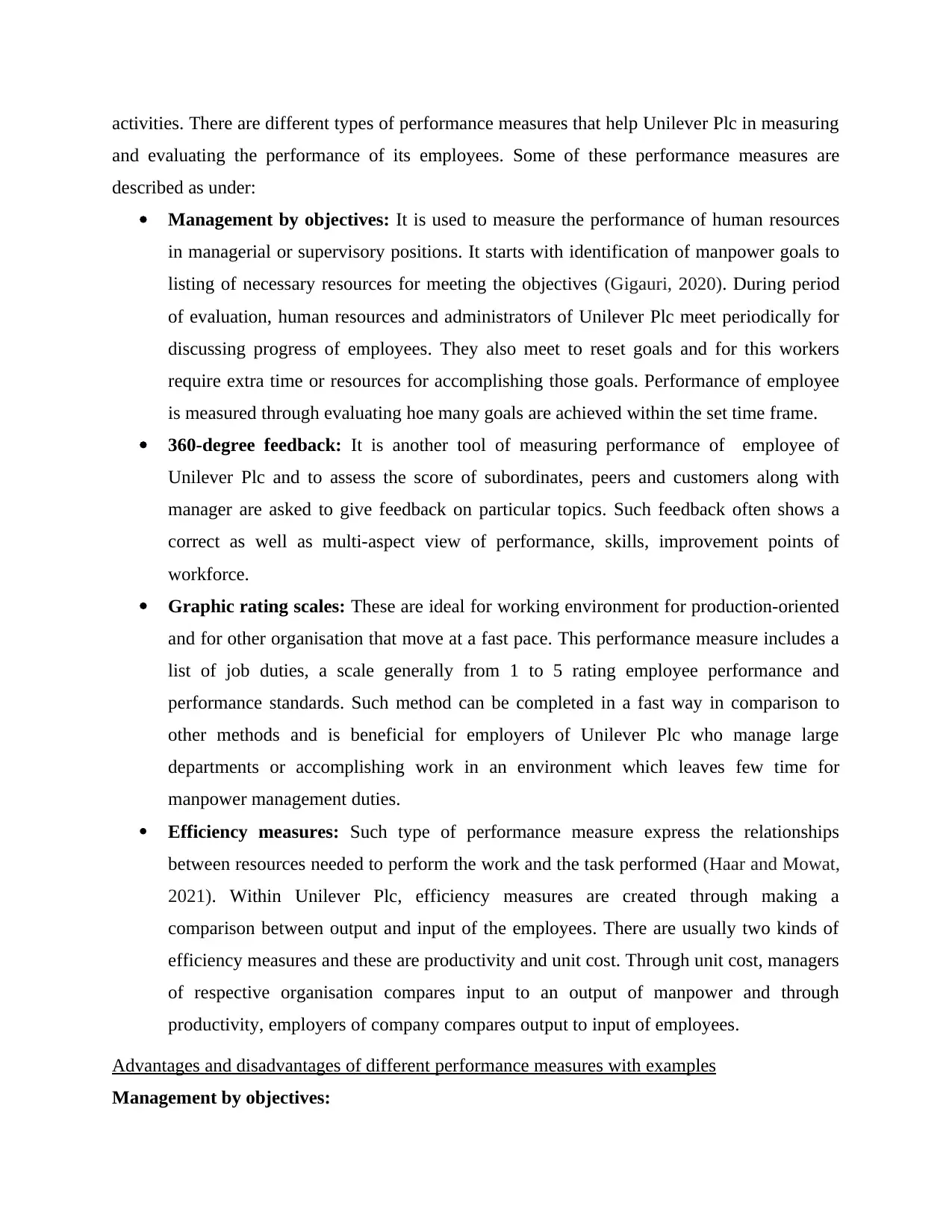
activities. There are different types of performance measures that help Unilever Plc in measuring
and evaluating the performance of its employees. Some of these performance measures are
described as under:
Management by objectives: It is used to measure the performance of human resources
in managerial or supervisory positions. It starts with identification of manpower goals to
listing of necessary resources for meeting the objectives (Gigauri, 2020). During period
of evaluation, human resources and administrators of Unilever Plc meet periodically for
discussing progress of employees. They also meet to reset goals and for this workers
require extra time or resources for accomplishing those goals. Performance of employee
is measured through evaluating hoe many goals are achieved within the set time frame.
360-degree feedback: It is another tool of measuring performance of employee of
Unilever Plc and to assess the score of subordinates, peers and customers along with
manager are asked to give feedback on particular topics. Such feedback often shows a
correct as well as multi-aspect view of performance, skills, improvement points of
workforce.
Graphic rating scales: These are ideal for working environment for production-oriented
and for other organisation that move at a fast pace. This performance measure includes a
list of job duties, a scale generally from 1 to 5 rating employee performance and
performance standards. Such method can be completed in a fast way in comparison to
other methods and is beneficial for employers of Unilever Plc who manage large
departments or accomplishing work in an environment which leaves few time for
manpower management duties.
Efficiency measures: Such type of performance measure express the relationships
between resources needed to perform the work and the task performed (Haar and Mowat,
2021). Within Unilever Plc, efficiency measures are created through making a
comparison between output and input of the employees. There are usually two kinds of
efficiency measures and these are productivity and unit cost. Through unit cost, managers
of respective organisation compares input to an output of manpower and through
productivity, employers of company compares output to input of employees.
Advantages and disadvantages of different performance measures with examples
Management by objectives:
and evaluating the performance of its employees. Some of these performance measures are
described as under:
Management by objectives: It is used to measure the performance of human resources
in managerial or supervisory positions. It starts with identification of manpower goals to
listing of necessary resources for meeting the objectives (Gigauri, 2020). During period
of evaluation, human resources and administrators of Unilever Plc meet periodically for
discussing progress of employees. They also meet to reset goals and for this workers
require extra time or resources for accomplishing those goals. Performance of employee
is measured through evaluating hoe many goals are achieved within the set time frame.
360-degree feedback: It is another tool of measuring performance of employee of
Unilever Plc and to assess the score of subordinates, peers and customers along with
manager are asked to give feedback on particular topics. Such feedback often shows a
correct as well as multi-aspect view of performance, skills, improvement points of
workforce.
Graphic rating scales: These are ideal for working environment for production-oriented
and for other organisation that move at a fast pace. This performance measure includes a
list of job duties, a scale generally from 1 to 5 rating employee performance and
performance standards. Such method can be completed in a fast way in comparison to
other methods and is beneficial for employers of Unilever Plc who manage large
departments or accomplishing work in an environment which leaves few time for
manpower management duties.
Efficiency measures: Such type of performance measure express the relationships
between resources needed to perform the work and the task performed (Haar and Mowat,
2021). Within Unilever Plc, efficiency measures are created through making a
comparison between output and input of the employees. There are usually two kinds of
efficiency measures and these are productivity and unit cost. Through unit cost, managers
of respective organisation compares input to an output of manpower and through
productivity, employers of company compares output to input of employees.
Advantages and disadvantages of different performance measures with examples
Management by objectives:
Paraphrase This Document
Need a fresh take? Get an instant paraphrase of this document with our AI Paraphraser
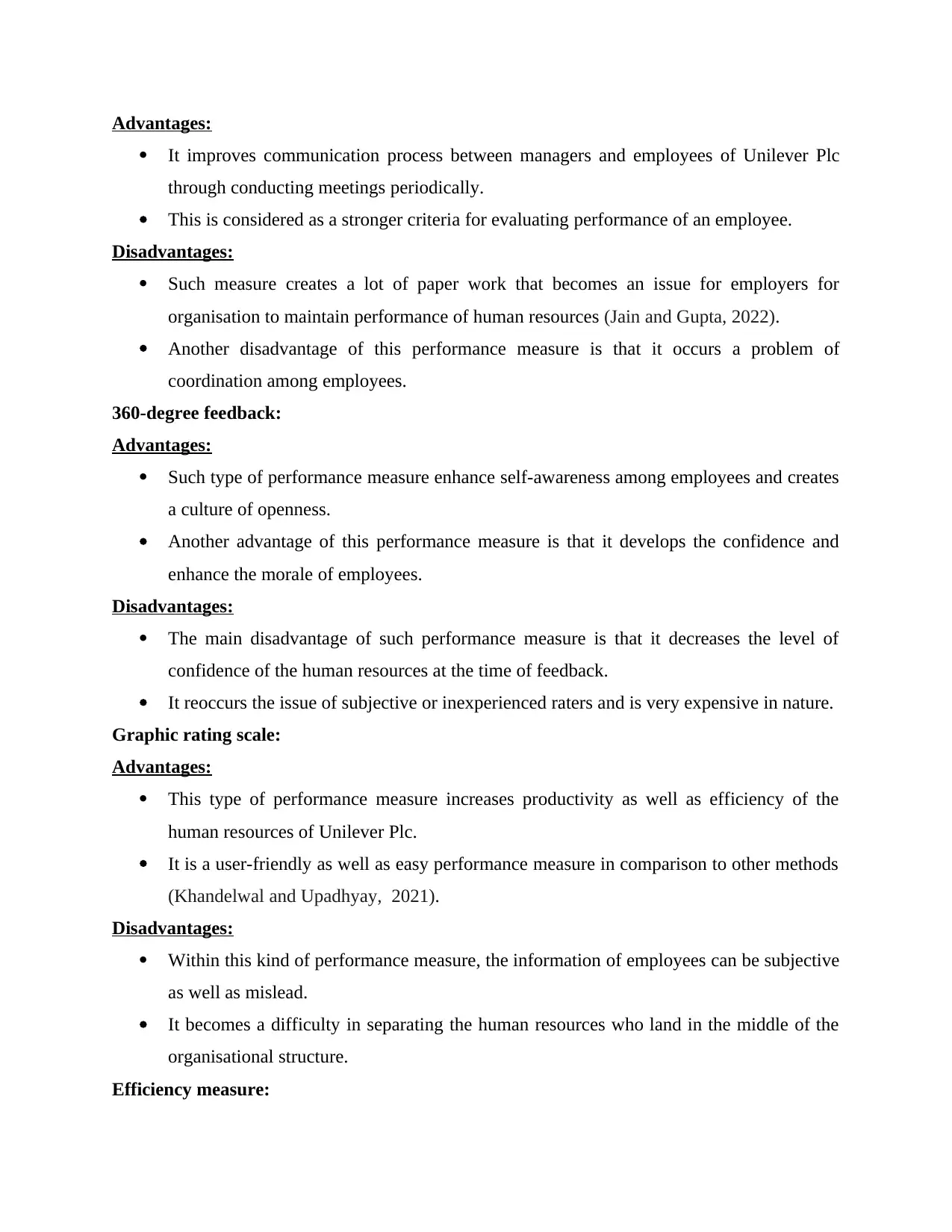
Advantages:
It improves communication process between managers and employees of Unilever Plc
through conducting meetings periodically.
This is considered as a stronger criteria for evaluating performance of an employee.
Disadvantages:
Such measure creates a lot of paper work that becomes an issue for employers for
organisation to maintain performance of human resources (Jain and Gupta, 2022).
Another disadvantage of this performance measure is that it occurs a problem of
coordination among employees.
360-degree feedback:
Advantages:
Such type of performance measure enhance self-awareness among employees and creates
a culture of openness.
Another advantage of this performance measure is that it develops the confidence and
enhance the morale of employees.
Disadvantages:
The main disadvantage of such performance measure is that it decreases the level of
confidence of the human resources at the time of feedback.
It reoccurs the issue of subjective or inexperienced raters and is very expensive in nature.
Graphic rating scale:
Advantages:
This type of performance measure increases productivity as well as efficiency of the
human resources of Unilever Plc.
It is a user-friendly as well as easy performance measure in comparison to other methods
(Khandelwal and Upadhyay, 2021).
Disadvantages:
Within this kind of performance measure, the information of employees can be subjective
as well as mislead.
It becomes a difficulty in separating the human resources who land in the middle of the
organisational structure.
Efficiency measure:
It improves communication process between managers and employees of Unilever Plc
through conducting meetings periodically.
This is considered as a stronger criteria for evaluating performance of an employee.
Disadvantages:
Such measure creates a lot of paper work that becomes an issue for employers for
organisation to maintain performance of human resources (Jain and Gupta, 2022).
Another disadvantage of this performance measure is that it occurs a problem of
coordination among employees.
360-degree feedback:
Advantages:
Such type of performance measure enhance self-awareness among employees and creates
a culture of openness.
Another advantage of this performance measure is that it develops the confidence and
enhance the morale of employees.
Disadvantages:
The main disadvantage of such performance measure is that it decreases the level of
confidence of the human resources at the time of feedback.
It reoccurs the issue of subjective or inexperienced raters and is very expensive in nature.
Graphic rating scale:
Advantages:
This type of performance measure increases productivity as well as efficiency of the
human resources of Unilever Plc.
It is a user-friendly as well as easy performance measure in comparison to other methods
(Khandelwal and Upadhyay, 2021).
Disadvantages:
Within this kind of performance measure, the information of employees can be subjective
as well as mislead.
It becomes a difficulty in separating the human resources who land in the middle of the
organisational structure.
Efficiency measure:
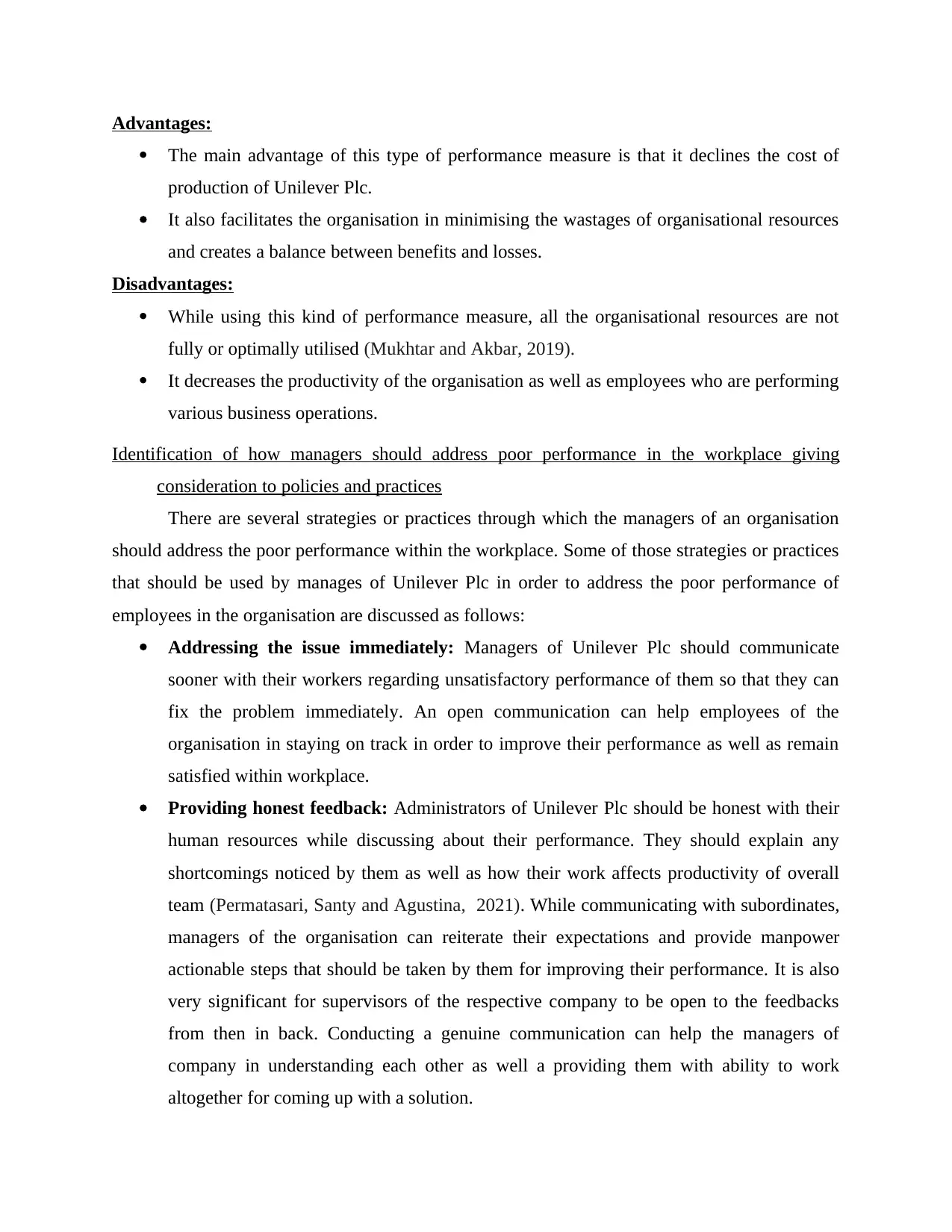
Advantages:
The main advantage of this type of performance measure is that it declines the cost of
production of Unilever Plc.
It also facilitates the organisation in minimising the wastages of organisational resources
and creates a balance between benefits and losses.
Disadvantages:
While using this kind of performance measure, all the organisational resources are not
fully or optimally utilised (Mukhtar and Akbar, 2019).
It decreases the productivity of the organisation as well as employees who are performing
various business operations.
Identification of how managers should address poor performance in the workplace giving
consideration to policies and practices
There are several strategies or practices through which the managers of an organisation
should address the poor performance within the workplace. Some of those strategies or practices
that should be used by manages of Unilever Plc in order to address the poor performance of
employees in the organisation are discussed as follows:
Addressing the issue immediately: Managers of Unilever Plc should communicate
sooner with their workers regarding unsatisfactory performance of them so that they can
fix the problem immediately. An open communication can help employees of the
organisation in staying on track in order to improve their performance as well as remain
satisfied within workplace.
Providing honest feedback: Administrators of Unilever Plc should be honest with their
human resources while discussing about their performance. They should explain any
shortcomings noticed by them as well as how their work affects productivity of overall
team (Permatasari, Santy and Agustina, 2021). While communicating with subordinates,
managers of the organisation can reiterate their expectations and provide manpower
actionable steps that should be taken by them for improving their performance. It is also
very significant for supervisors of the respective company to be open to the feedbacks
from then in back. Conducting a genuine communication can help the managers of
company in understanding each other as well a providing them with ability to work
altogether for coming up with a solution.
The main advantage of this type of performance measure is that it declines the cost of
production of Unilever Plc.
It also facilitates the organisation in minimising the wastages of organisational resources
and creates a balance between benefits and losses.
Disadvantages:
While using this kind of performance measure, all the organisational resources are not
fully or optimally utilised (Mukhtar and Akbar, 2019).
It decreases the productivity of the organisation as well as employees who are performing
various business operations.
Identification of how managers should address poor performance in the workplace giving
consideration to policies and practices
There are several strategies or practices through which the managers of an organisation
should address the poor performance within the workplace. Some of those strategies or practices
that should be used by manages of Unilever Plc in order to address the poor performance of
employees in the organisation are discussed as follows:
Addressing the issue immediately: Managers of Unilever Plc should communicate
sooner with their workers regarding unsatisfactory performance of them so that they can
fix the problem immediately. An open communication can help employees of the
organisation in staying on track in order to improve their performance as well as remain
satisfied within workplace.
Providing honest feedback: Administrators of Unilever Plc should be honest with their
human resources while discussing about their performance. They should explain any
shortcomings noticed by them as well as how their work affects productivity of overall
team (Permatasari, Santy and Agustina, 2021). While communicating with subordinates,
managers of the organisation can reiterate their expectations and provide manpower
actionable steps that should be taken by them for improving their performance. It is also
very significant for supervisors of the respective company to be open to the feedbacks
from then in back. Conducting a genuine communication can help the managers of
company in understanding each other as well a providing them with ability to work
altogether for coming up with a solution.
⊘ This is a preview!⊘
Do you want full access?
Subscribe today to unlock all pages.

Trusted by 1+ million students worldwide
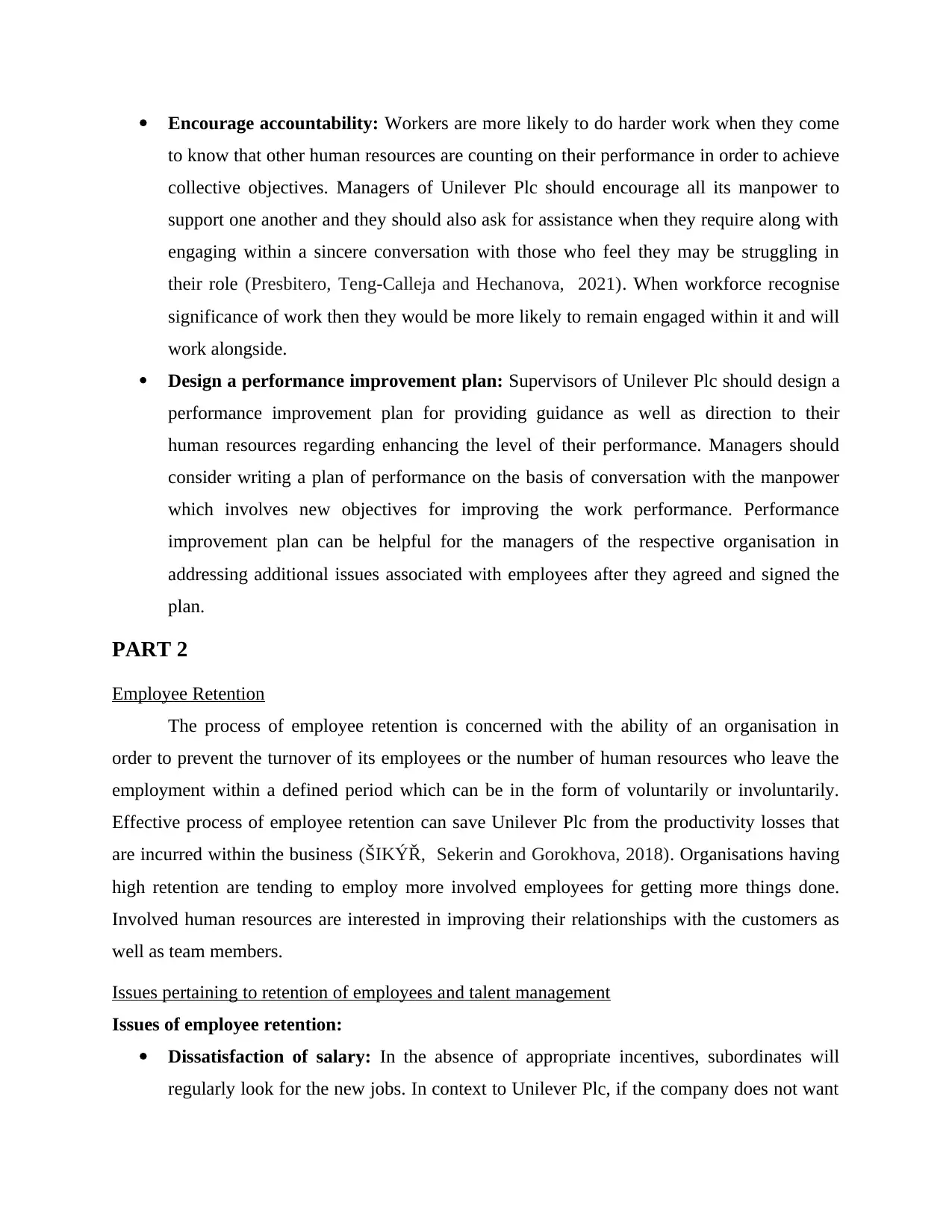
Encourage accountability: Workers are more likely to do harder work when they come
to know that other human resources are counting on their performance in order to achieve
collective objectives. Managers of Unilever Plc should encourage all its manpower to
support one another and they should also ask for assistance when they require along with
engaging within a sincere conversation with those who feel they may be struggling in
their role (Presbitero, Teng‐Calleja and Hechanova, 2021). When workforce recognise
significance of work then they would be more likely to remain engaged within it and will
work alongside.
Design a performance improvement plan: Supervisors of Unilever Plc should design a
performance improvement plan for providing guidance as well as direction to their
human resources regarding enhancing the level of their performance. Managers should
consider writing a plan of performance on the basis of conversation with the manpower
which involves new objectives for improving the work performance. Performance
improvement plan can be helpful for the managers of the respective organisation in
addressing additional issues associated with employees after they agreed and signed the
plan.
PART 2
Employee Retention
The process of employee retention is concerned with the ability of an organisation in
order to prevent the turnover of its employees or the number of human resources who leave the
employment within a defined period which can be in the form of voluntarily or involuntarily.
Effective process of employee retention can save Unilever Plc from the productivity losses that
are incurred within the business (ŠIKÝŘ, Sekerin and Gorokhova, 2018). Organisations having
high retention are tending to employ more involved employees for getting more things done.
Involved human resources are interested in improving their relationships with the customers as
well as team members.
Issues pertaining to retention of employees and talent management
Issues of employee retention:
Dissatisfaction of salary: In the absence of appropriate incentives, subordinates will
regularly look for the new jobs. In context to Unilever Plc, if the company does not want
to know that other human resources are counting on their performance in order to achieve
collective objectives. Managers of Unilever Plc should encourage all its manpower to
support one another and they should also ask for assistance when they require along with
engaging within a sincere conversation with those who feel they may be struggling in
their role (Presbitero, Teng‐Calleja and Hechanova, 2021). When workforce recognise
significance of work then they would be more likely to remain engaged within it and will
work alongside.
Design a performance improvement plan: Supervisors of Unilever Plc should design a
performance improvement plan for providing guidance as well as direction to their
human resources regarding enhancing the level of their performance. Managers should
consider writing a plan of performance on the basis of conversation with the manpower
which involves new objectives for improving the work performance. Performance
improvement plan can be helpful for the managers of the respective organisation in
addressing additional issues associated with employees after they agreed and signed the
plan.
PART 2
Employee Retention
The process of employee retention is concerned with the ability of an organisation in
order to prevent the turnover of its employees or the number of human resources who leave the
employment within a defined period which can be in the form of voluntarily or involuntarily.
Effective process of employee retention can save Unilever Plc from the productivity losses that
are incurred within the business (ŠIKÝŘ, Sekerin and Gorokhova, 2018). Organisations having
high retention are tending to employ more involved employees for getting more things done.
Involved human resources are interested in improving their relationships with the customers as
well as team members.
Issues pertaining to retention of employees and talent management
Issues of employee retention:
Dissatisfaction of salary: In the absence of appropriate incentives, subordinates will
regularly look for the new jobs. In context to Unilever Plc, if the company does not want
Paraphrase This Document
Need a fresh take? Get an instant paraphrase of this document with our AI Paraphraser
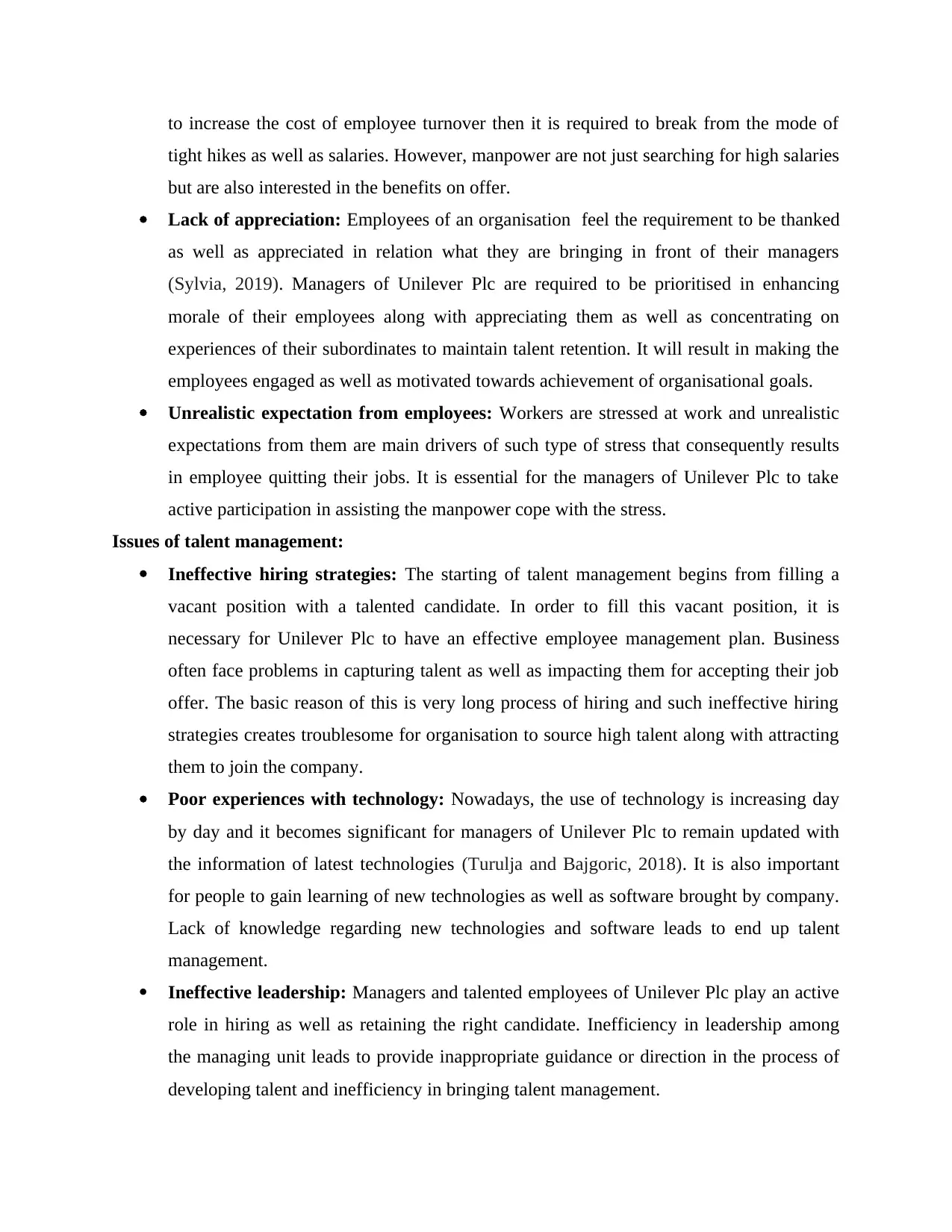
to increase the cost of employee turnover then it is required to break from the mode of
tight hikes as well as salaries. However, manpower are not just searching for high salaries
but are also interested in the benefits on offer.
Lack of appreciation: Employees of an organisation feel the requirement to be thanked
as well as appreciated in relation what they are bringing in front of their managers
(Sylvia, 2019). Managers of Unilever Plc are required to be prioritised in enhancing
morale of their employees along with appreciating them as well as concentrating on
experiences of their subordinates to maintain talent retention. It will result in making the
employees engaged as well as motivated towards achievement of organisational goals.
Unrealistic expectation from employees: Workers are stressed at work and unrealistic
expectations from them are main drivers of such type of stress that consequently results
in employee quitting their jobs. It is essential for the managers of Unilever Plc to take
active participation in assisting the manpower cope with the stress.
Issues of talent management:
Ineffective hiring strategies: The starting of talent management begins from filling a
vacant position with a talented candidate. In order to fill this vacant position, it is
necessary for Unilever Plc to have an effective employee management plan. Business
often face problems in capturing talent as well as impacting them for accepting their job
offer. The basic reason of this is very long process of hiring and such ineffective hiring
strategies creates troublesome for organisation to source high talent along with attracting
them to join the company.
Poor experiences with technology: Nowadays, the use of technology is increasing day
by day and it becomes significant for managers of Unilever Plc to remain updated with
the information of latest technologies (Turulja and Bajgoric, 2018). It is also important
for people to gain learning of new technologies as well as software brought by company.
Lack of knowledge regarding new technologies and software leads to end up talent
management.
Ineffective leadership: Managers and talented employees of Unilever Plc play an active
role in hiring as well as retaining the right candidate. Inefficiency in leadership among
the managing unit leads to provide inappropriate guidance or direction in the process of
developing talent and inefficiency in bringing talent management.
tight hikes as well as salaries. However, manpower are not just searching for high salaries
but are also interested in the benefits on offer.
Lack of appreciation: Employees of an organisation feel the requirement to be thanked
as well as appreciated in relation what they are bringing in front of their managers
(Sylvia, 2019). Managers of Unilever Plc are required to be prioritised in enhancing
morale of their employees along with appreciating them as well as concentrating on
experiences of their subordinates to maintain talent retention. It will result in making the
employees engaged as well as motivated towards achievement of organisational goals.
Unrealistic expectation from employees: Workers are stressed at work and unrealistic
expectations from them are main drivers of such type of stress that consequently results
in employee quitting their jobs. It is essential for the managers of Unilever Plc to take
active participation in assisting the manpower cope with the stress.
Issues of talent management:
Ineffective hiring strategies: The starting of talent management begins from filling a
vacant position with a talented candidate. In order to fill this vacant position, it is
necessary for Unilever Plc to have an effective employee management plan. Business
often face problems in capturing talent as well as impacting them for accepting their job
offer. The basic reason of this is very long process of hiring and such ineffective hiring
strategies creates troublesome for organisation to source high talent along with attracting
them to join the company.
Poor experiences with technology: Nowadays, the use of technology is increasing day
by day and it becomes significant for managers of Unilever Plc to remain updated with
the information of latest technologies (Turulja and Bajgoric, 2018). It is also important
for people to gain learning of new technologies as well as software brought by company.
Lack of knowledge regarding new technologies and software leads to end up talent
management.
Ineffective leadership: Managers and talented employees of Unilever Plc play an active
role in hiring as well as retaining the right candidate. Inefficiency in leadership among
the managing unit leads to provide inappropriate guidance or direction in the process of
developing talent and inefficiency in bringing talent management.
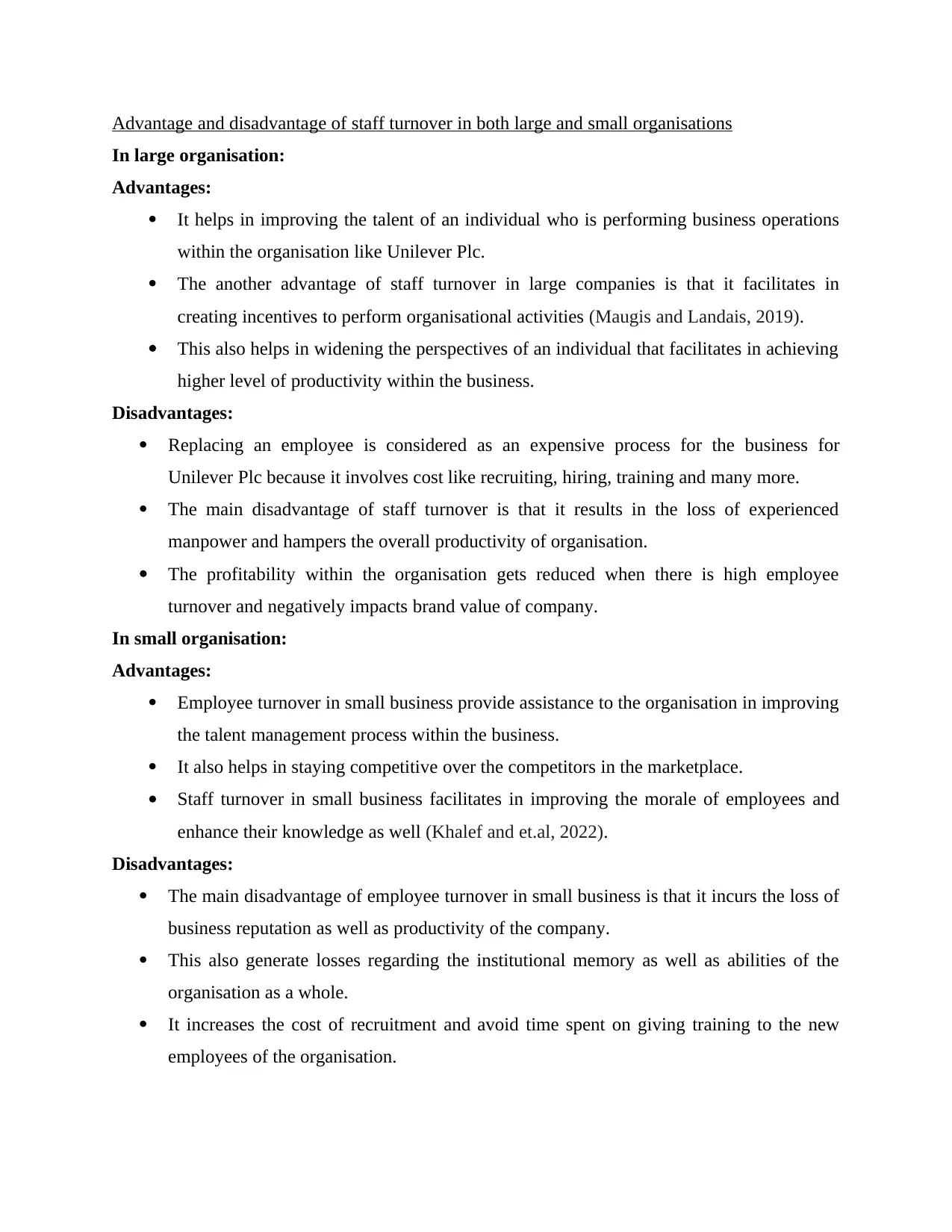
Advantage and disadvantage of staff turnover in both large and small organisations
In large organisation:
Advantages:
It helps in improving the talent of an individual who is performing business operations
within the organisation like Unilever Plc.
The another advantage of staff turnover in large companies is that it facilitates in
creating incentives to perform organisational activities (Maugis and Landais, 2019).
This also helps in widening the perspectives of an individual that facilitates in achieving
higher level of productivity within the business.
Disadvantages:
Replacing an employee is considered as an expensive process for the business for
Unilever Plc because it involves cost like recruiting, hiring, training and many more.
The main disadvantage of staff turnover is that it results in the loss of experienced
manpower and hampers the overall productivity of organisation.
The profitability within the organisation gets reduced when there is high employee
turnover and negatively impacts brand value of company.
In small organisation:
Advantages:
Employee turnover in small business provide assistance to the organisation in improving
the talent management process within the business.
It also helps in staying competitive over the competitors in the marketplace.
Staff turnover in small business facilitates in improving the morale of employees and
enhance their knowledge as well (Khalef and et.al, 2022).
Disadvantages:
The main disadvantage of employee turnover in small business is that it incurs the loss of
business reputation as well as productivity of the company.
This also generate losses regarding the institutional memory as well as abilities of the
organisation as a whole.
It increases the cost of recruitment and avoid time spent on giving training to the new
employees of the organisation.
In large organisation:
Advantages:
It helps in improving the talent of an individual who is performing business operations
within the organisation like Unilever Plc.
The another advantage of staff turnover in large companies is that it facilitates in
creating incentives to perform organisational activities (Maugis and Landais, 2019).
This also helps in widening the perspectives of an individual that facilitates in achieving
higher level of productivity within the business.
Disadvantages:
Replacing an employee is considered as an expensive process for the business for
Unilever Plc because it involves cost like recruiting, hiring, training and many more.
The main disadvantage of staff turnover is that it results in the loss of experienced
manpower and hampers the overall productivity of organisation.
The profitability within the organisation gets reduced when there is high employee
turnover and negatively impacts brand value of company.
In small organisation:
Advantages:
Employee turnover in small business provide assistance to the organisation in improving
the talent management process within the business.
It also helps in staying competitive over the competitors in the marketplace.
Staff turnover in small business facilitates in improving the morale of employees and
enhance their knowledge as well (Khalef and et.al, 2022).
Disadvantages:
The main disadvantage of employee turnover in small business is that it incurs the loss of
business reputation as well as productivity of the company.
This also generate losses regarding the institutional memory as well as abilities of the
organisation as a whole.
It increases the cost of recruitment and avoid time spent on giving training to the new
employees of the organisation.
⊘ This is a preview!⊘
Do you want full access?
Subscribe today to unlock all pages.

Trusted by 1+ million students worldwide
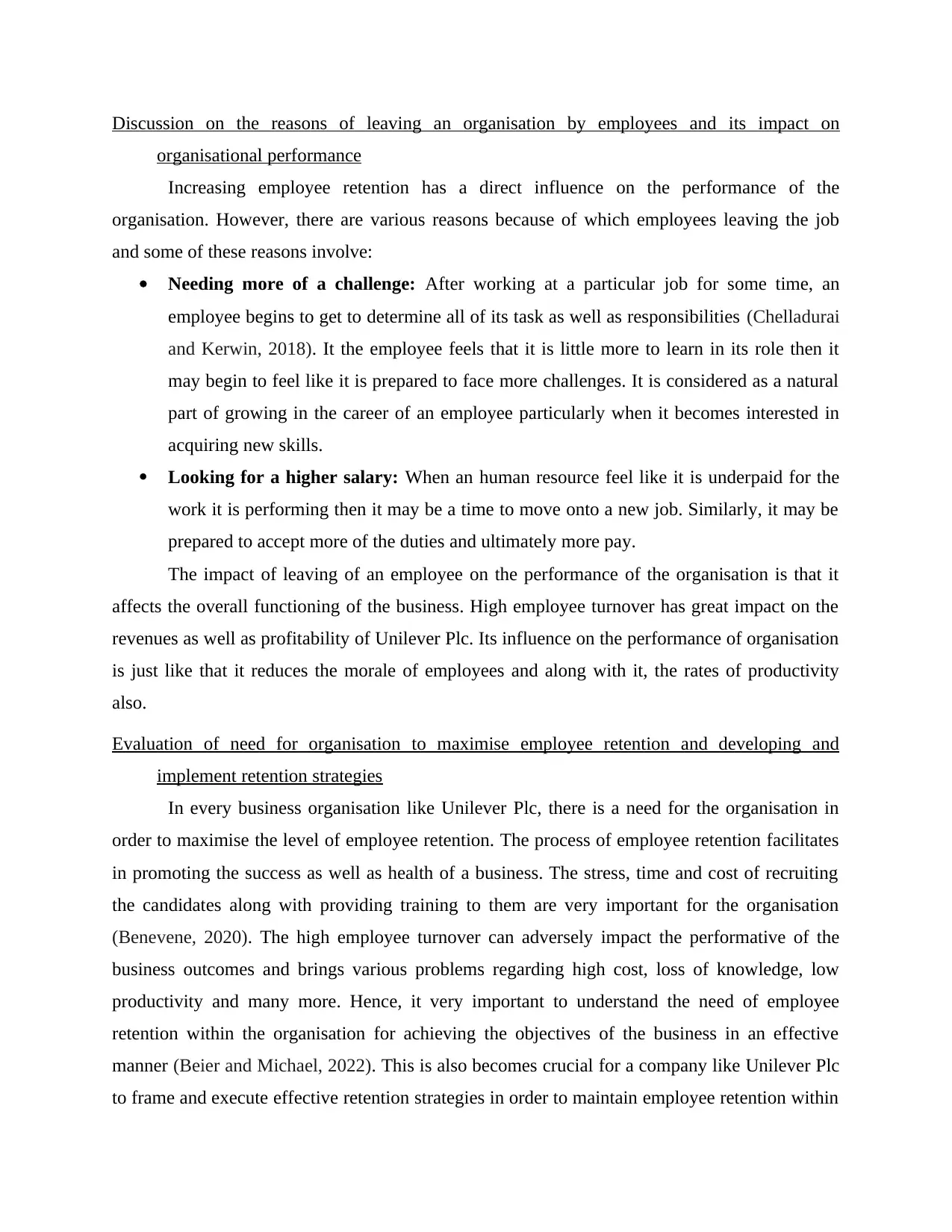
Discussion on the reasons of leaving an organisation by employees and its impact on
organisational performance
Increasing employee retention has a direct influence on the performance of the
organisation. However, there are various reasons because of which employees leaving the job
and some of these reasons involve:
Needing more of a challenge: After working at a particular job for some time, an
employee begins to get to determine all of its task as well as responsibilities (Chelladurai
and Kerwin, 2018). It the employee feels that it is little more to learn in its role then it
may begin to feel like it is prepared to face more challenges. It is considered as a natural
part of growing in the career of an employee particularly when it becomes interested in
acquiring new skills.
Looking for a higher salary: When an human resource feel like it is underpaid for the
work it is performing then it may be a time to move onto a new job. Similarly, it may be
prepared to accept more of the duties and ultimately more pay.
The impact of leaving of an employee on the performance of the organisation is that it
affects the overall functioning of the business. High employee turnover has great impact on the
revenues as well as profitability of Unilever Plc. Its influence on the performance of organisation
is just like that it reduces the morale of employees and along with it, the rates of productivity
also.
Evaluation of need for organisation to maximise employee retention and developing and
implement retention strategies
In every business organisation like Unilever Plc, there is a need for the organisation in
order to maximise the level of employee retention. The process of employee retention facilitates
in promoting the success as well as health of a business. The stress, time and cost of recruiting
the candidates along with providing training to them are very important for the organisation
(Benevene, 2020). The high employee turnover can adversely impact the performative of the
business outcomes and brings various problems regarding high cost, loss of knowledge, low
productivity and many more. Hence, it very important to understand the need of employee
retention within the organisation for achieving the objectives of the business in an effective
manner (Beier and Michael, 2022). This is also becomes crucial for a company like Unilever Plc
to frame and execute effective retention strategies in order to maintain employee retention within
organisational performance
Increasing employee retention has a direct influence on the performance of the
organisation. However, there are various reasons because of which employees leaving the job
and some of these reasons involve:
Needing more of a challenge: After working at a particular job for some time, an
employee begins to get to determine all of its task as well as responsibilities (Chelladurai
and Kerwin, 2018). It the employee feels that it is little more to learn in its role then it
may begin to feel like it is prepared to face more challenges. It is considered as a natural
part of growing in the career of an employee particularly when it becomes interested in
acquiring new skills.
Looking for a higher salary: When an human resource feel like it is underpaid for the
work it is performing then it may be a time to move onto a new job. Similarly, it may be
prepared to accept more of the duties and ultimately more pay.
The impact of leaving of an employee on the performance of the organisation is that it
affects the overall functioning of the business. High employee turnover has great impact on the
revenues as well as profitability of Unilever Plc. Its influence on the performance of organisation
is just like that it reduces the morale of employees and along with it, the rates of productivity
also.
Evaluation of need for organisation to maximise employee retention and developing and
implement retention strategies
In every business organisation like Unilever Plc, there is a need for the organisation in
order to maximise the level of employee retention. The process of employee retention facilitates
in promoting the success as well as health of a business. The stress, time and cost of recruiting
the candidates along with providing training to them are very important for the organisation
(Benevene, 2020). The high employee turnover can adversely impact the performative of the
business outcomes and brings various problems regarding high cost, loss of knowledge, low
productivity and many more. Hence, it very important to understand the need of employee
retention within the organisation for achieving the objectives of the business in an effective
manner (Beier and Michael, 2022). This is also becomes crucial for a company like Unilever Plc
to frame and execute effective retention strategies in order to maintain employee retention within
Paraphrase This Document
Need a fresh take? Get an instant paraphrase of this document with our AI Paraphraser
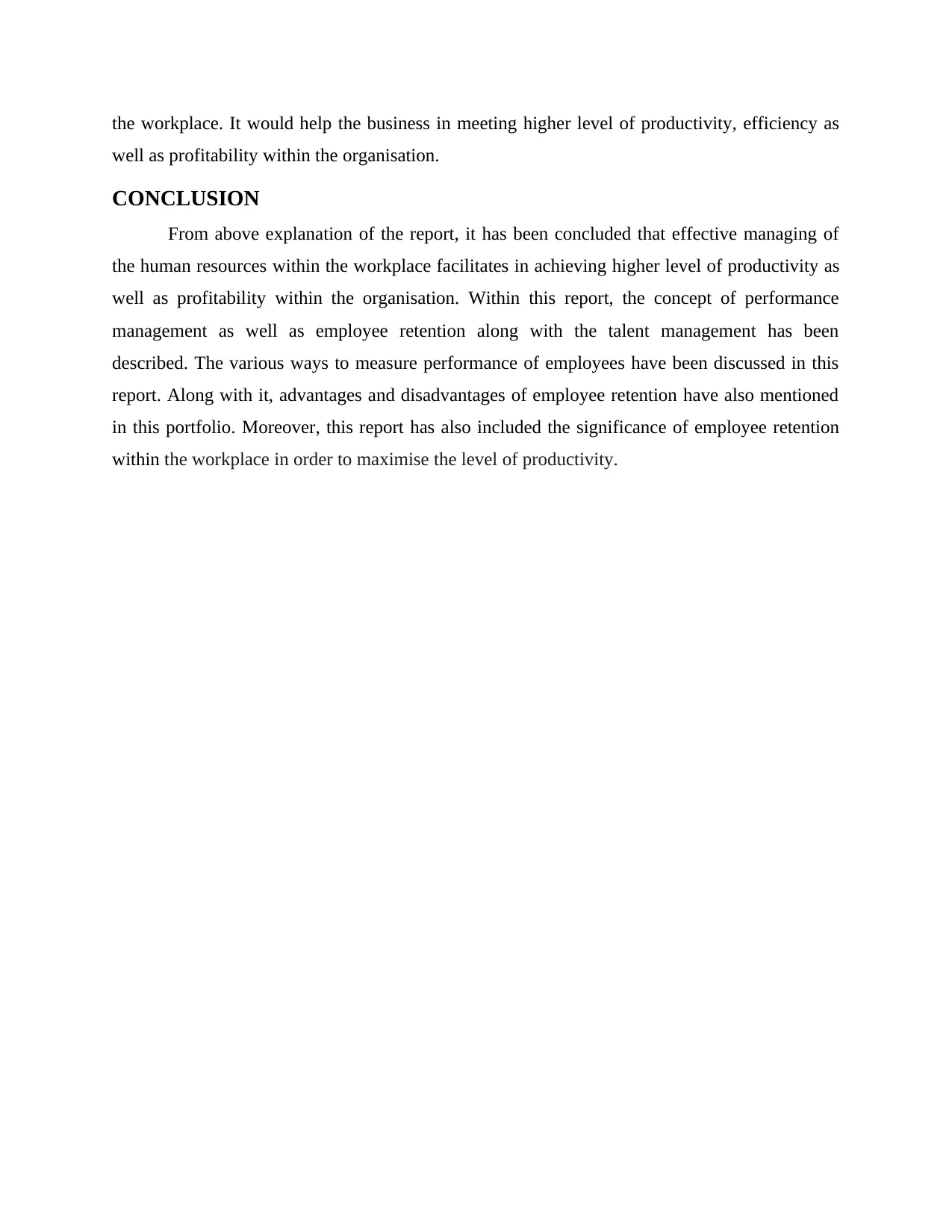
the workplace. It would help the business in meeting higher level of productivity, efficiency as
well as profitability within the organisation.
CONCLUSION
From above explanation of the report, it has been concluded that effective managing of
the human resources within the workplace facilitates in achieving higher level of productivity as
well as profitability within the organisation. Within this report, the concept of performance
management as well as employee retention along with the talent management has been
described. The various ways to measure performance of employees have been discussed in this
report. Along with it, advantages and disadvantages of employee retention have also mentioned
in this portfolio. Moreover, this report has also included the significance of employee retention
within the workplace in order to maximise the level of productivity.
well as profitability within the organisation.
CONCLUSION
From above explanation of the report, it has been concluded that effective managing of
the human resources within the workplace facilitates in achieving higher level of productivity as
well as profitability within the organisation. Within this report, the concept of performance
management as well as employee retention along with the talent management has been
described. The various ways to measure performance of employees have been discussed in this
report. Along with it, advantages and disadvantages of employee retention have also mentioned
in this portfolio. Moreover, this report has also included the significance of employee retention
within the workplace in order to maximise the level of productivity.
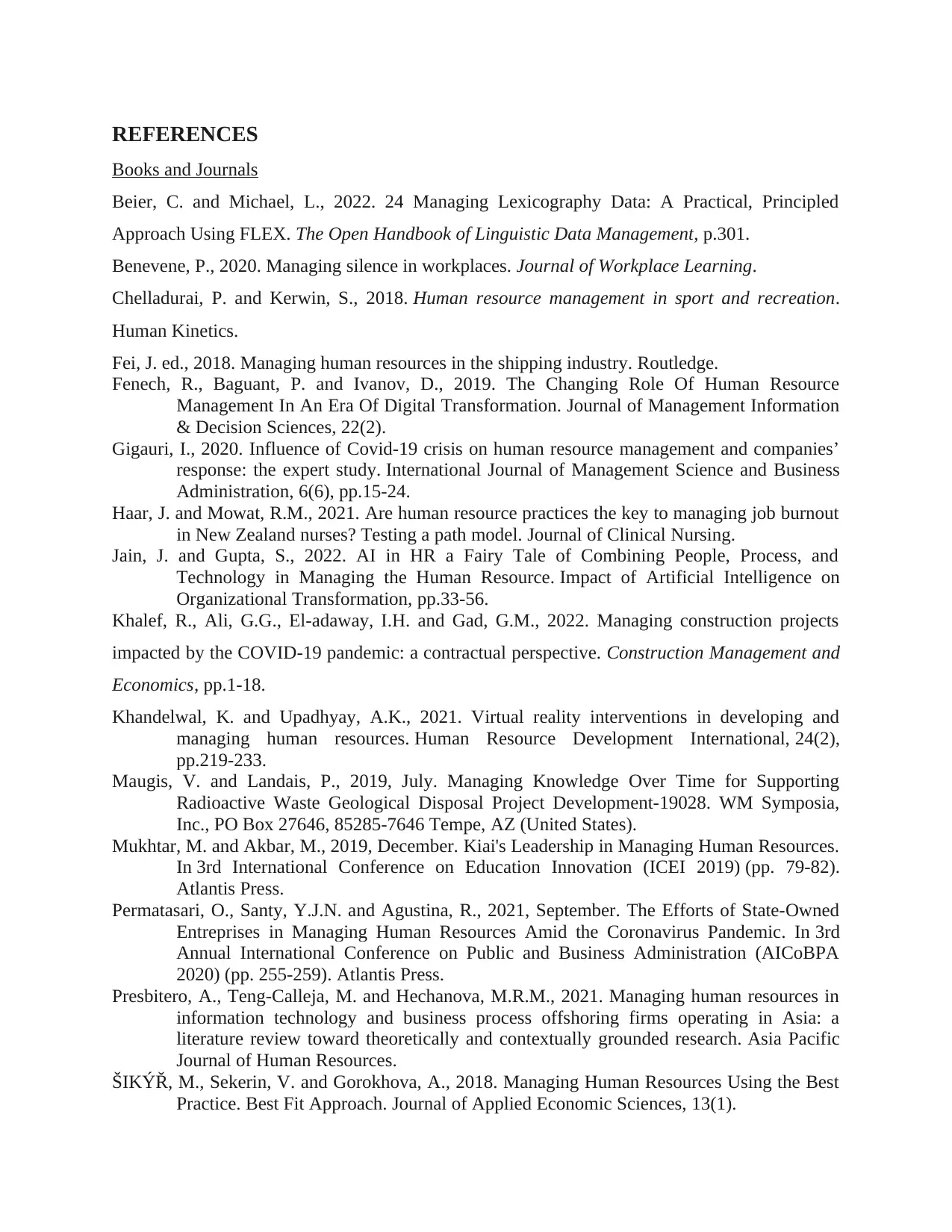
REFERENCES
Books and Journals
Beier, C. and Michael, L., 2022. 24 Managing Lexicography Data: A Practical, Principled
Approach Using FLEX. The Open Handbook of Linguistic Data Management, p.301.
Benevene, P., 2020. Managing silence in workplaces. Journal of Workplace Learning.
Chelladurai, P. and Kerwin, S., 2018. Human resource management in sport and recreation.
Human Kinetics.
Fei, J. ed., 2018. Managing human resources in the shipping industry. Routledge.
Fenech, R., Baguant, P. and Ivanov, D., 2019. The Changing Role Of Human Resource
Management In An Era Of Digital Transformation. Journal of Management Information
& Decision Sciences, 22(2).
Gigauri, I., 2020. Influence of Covid-19 crisis on human resource management and companies’
response: the expert study. International Journal of Management Science and Business
Administration, 6(6), pp.15-24.
Haar, J. and Mowat, R.M., 2021. Are human resource practices the key to managing job burnout
in New Zealand nurses? Testing a path model. Journal of Clinical Nursing.
Jain, J. and Gupta, S., 2022. AI in HR a Fairy Tale of Combining People, Process, and
Technology in Managing the Human Resource. Impact of Artificial Intelligence on
Organizational Transformation, pp.33-56.
Khalef, R., Ali, G.G., El-adaway, I.H. and Gad, G.M., 2022. Managing construction projects
impacted by the COVID-19 pandemic: a contractual perspective. Construction Management and
Economics, pp.1-18.
Khandelwal, K. and Upadhyay, A.K., 2021. Virtual reality interventions in developing and
managing human resources. Human Resource Development International, 24(2),
pp.219-233.
Maugis, V. and Landais, P., 2019, July. Managing Knowledge Over Time for Supporting
Radioactive Waste Geological Disposal Project Development-19028. WM Symposia,
Inc., PO Box 27646, 85285-7646 Tempe, AZ (United States).
Mukhtar, M. and Akbar, M., 2019, December. Kiai's Leadership in Managing Human Resources.
In 3rd International Conference on Education Innovation (ICEI 2019) (pp. 79-82).
Atlantis Press.
Permatasari, O., Santy, Y.J.N. and Agustina, R., 2021, September. The Efforts of State-Owned
Entreprises in Managing Human Resources Amid the Coronavirus Pandemic. In 3rd
Annual International Conference on Public and Business Administration (AICoBPA
2020) (pp. 255-259). Atlantis Press.
Presbitero, A., Teng‐Calleja, M. and Hechanova, M.R.M., 2021. Managing human resources in
information technology and business process offshoring firms operating in Asia: a
literature review toward theoretically and contextually grounded research. Asia Pacific
Journal of Human Resources.
ŠIKÝŘ, M., Sekerin, V. and Gorokhova, A., 2018. Managing Human Resources Using the Best
Practice. Best Fit Approach. Journal of Applied Economic Sciences, 13(1).
Books and Journals
Beier, C. and Michael, L., 2022. 24 Managing Lexicography Data: A Practical, Principled
Approach Using FLEX. The Open Handbook of Linguistic Data Management, p.301.
Benevene, P., 2020. Managing silence in workplaces. Journal of Workplace Learning.
Chelladurai, P. and Kerwin, S., 2018. Human resource management in sport and recreation.
Human Kinetics.
Fei, J. ed., 2018. Managing human resources in the shipping industry. Routledge.
Fenech, R., Baguant, P. and Ivanov, D., 2019. The Changing Role Of Human Resource
Management In An Era Of Digital Transformation. Journal of Management Information
& Decision Sciences, 22(2).
Gigauri, I., 2020. Influence of Covid-19 crisis on human resource management and companies’
response: the expert study. International Journal of Management Science and Business
Administration, 6(6), pp.15-24.
Haar, J. and Mowat, R.M., 2021. Are human resource practices the key to managing job burnout
in New Zealand nurses? Testing a path model. Journal of Clinical Nursing.
Jain, J. and Gupta, S., 2022. AI in HR a Fairy Tale of Combining People, Process, and
Technology in Managing the Human Resource. Impact of Artificial Intelligence on
Organizational Transformation, pp.33-56.
Khalef, R., Ali, G.G., El-adaway, I.H. and Gad, G.M., 2022. Managing construction projects
impacted by the COVID-19 pandemic: a contractual perspective. Construction Management and
Economics, pp.1-18.
Khandelwal, K. and Upadhyay, A.K., 2021. Virtual reality interventions in developing and
managing human resources. Human Resource Development International, 24(2),
pp.219-233.
Maugis, V. and Landais, P., 2019, July. Managing Knowledge Over Time for Supporting
Radioactive Waste Geological Disposal Project Development-19028. WM Symposia,
Inc., PO Box 27646, 85285-7646 Tempe, AZ (United States).
Mukhtar, M. and Akbar, M., 2019, December. Kiai's Leadership in Managing Human Resources.
In 3rd International Conference on Education Innovation (ICEI 2019) (pp. 79-82).
Atlantis Press.
Permatasari, O., Santy, Y.J.N. and Agustina, R., 2021, September. The Efforts of State-Owned
Entreprises in Managing Human Resources Amid the Coronavirus Pandemic. In 3rd
Annual International Conference on Public and Business Administration (AICoBPA
2020) (pp. 255-259). Atlantis Press.
Presbitero, A., Teng‐Calleja, M. and Hechanova, M.R.M., 2021. Managing human resources in
information technology and business process offshoring firms operating in Asia: a
literature review toward theoretically and contextually grounded research. Asia Pacific
Journal of Human Resources.
ŠIKÝŘ, M., Sekerin, V. and Gorokhova, A., 2018. Managing Human Resources Using the Best
Practice. Best Fit Approach. Journal of Applied Economic Sciences, 13(1).
⊘ This is a preview!⊘
Do you want full access?
Subscribe today to unlock all pages.

Trusted by 1+ million students worldwide
1 out of 13
Related Documents
Your All-in-One AI-Powered Toolkit for Academic Success.
+13062052269
info@desklib.com
Available 24*7 on WhatsApp / Email
![[object Object]](/_next/static/media/star-bottom.7253800d.svg)
Unlock your academic potential
Copyright © 2020–2025 A2Z Services. All Rights Reserved. Developed and managed by ZUCOL.
![[TYPE THE COMPANY NAME] Graduate Challenge: Business Function Report](/_next/image/?url=https%3A%2F%2Fdesklib.com%2Fmedia%2Funilever-plc-functions-interlinkages-report_page_2.jpg&w=256&q=75)


